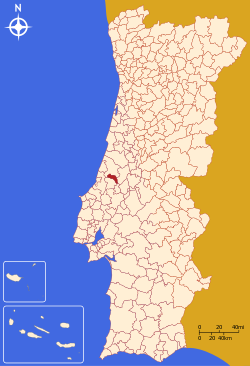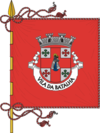Today we're back with the second part of the " Travel to Portugal". This time we went to a place called Batalha.The town was founded by King D. João I of Portugal, jointly with the Monastery of Santa Maria da Vitória na Batalha, to pay homage to the Portuguese victory at the Battle of Aljubarrota (August 14, 1385) that put an end to the 1383-1385 crisis. The town's name means battle. 1
Dzisiaj wracamy z drugą częścią z cyklu "Podróżujemy po Portugalii". Tym razem udaliśmy się do miejscowości o nazwie Batalha. Została założona wraz z ufundowaniem Klasztoru Matki Boskiej Zwycięskiej (Mosteiro de Santa Maria da Vitória) przez króla Portugalii Jana I w podzięce za cudowną interwencję Matki Boskiej i zwycięstwo nad Hiszpanami w bitwie pod Aljubarrotą ("batalha" znaczy po portugalsku "bitwa"). 1
More about the trip in read more / Więcej o wycieczce w czytaj więcej
More information about Batalha / Batalha - więcej informacji 2
| Batalha | ||||
|---|---|---|---|---|
| Municipality / Gmina | ||||
|
||||
 |
||||
| Coordinates / Położenie: 39°39′N 8°48′W | ||||
| Country / Państwo | ||||
| Region | Centro / Centrum | |||
| Subregion / Podregion | Pinhal Litoral | |||
| Intermunic. comm. | Região de Leiria | |||
| District / Dystrykt | Leiria | |||
| Parishes / Liczba sołectw | 4 | |||
| Area / Powierzchnia | ||||
| • Total / Całkowita | 103.42 km2 (39.93 sq mi) | |||
| Population / Zaludnienie (2011) | ||||
| • Total / Całkowite | 15,805 | |||
| • Density / Gęstość | 150/km2 (400/sq mi) | |||
| Time zone / strefa Czasowa | WET/WEST (UTC+0/+1) | |||
| Website | www | |||
================================================================
Batalha Monastery / Klasztor w Batalha

Mole Bartek was only for a moment in Batalha, but had an opportunity to take a few pictures on the popular and doing a great impression The Monastery of Batalha. Monastery of Santa Maria da Vitóri (Mosteiro de Santa Maria da Vitoria) is the Temple considered one of the finest and most celebrated monuments in Portugal and one of the greatest works of Gothic church architecture in Europe.
Krecik Bartek był tylko na chwile w Batalha, ale zdążył zrobić sobie kilka zdjęć przy popularnym i robiącym wielkie wrażenie Klasztorze. Klasztor Matki Boskiej Zwycięskiej (Mosteiro de Santa Maria da Vitória) jest Świątynią uważaną za jedną z najwspanialszych i najznamienitszych zabytków w Portugalii jak i jedno z najwybitniejszych dzieł gotyckiej architektury sakralnej w Europie.
 In 1983, the Monastery was listed on a UNESCO list - The World Cultural and Natural Heritage. Construction of the Monastery started in 1385 and was initiated thanks to King John I, in gratitude for the help of the Virgin Mary and the victory at the Battle of Aljubarrota. It lasted nearly 150 years. Successive rulers tried to leave their mark on the Monastery, adding new buildings or remodeling existing ones. Together with the Monastery the town of Batalha (port. Batalha - battle) was founded. In 1388 years, the Monastery was dedicated to the Dominicans and exercised over it bakes until the liquidation of religious orders in 1834. The architectural design, which was the construction of the Monastery, served mainly a demonstration of royal power. It became a symbol launched by John I of Aviz Dynasty and a new era in the history of Portugal. The monastery is considered a model example of a combination of English Gothic architecture and elements of home style Manueline.
In 1983, the Monastery was listed on a UNESCO list - The World Cultural and Natural Heritage. Construction of the Monastery started in 1385 and was initiated thanks to King John I, in gratitude for the help of the Virgin Mary and the victory at the Battle of Aljubarrota. It lasted nearly 150 years. Successive rulers tried to leave their mark on the Monastery, adding new buildings or remodeling existing ones. Together with the Monastery the town of Batalha (port. Batalha - battle) was founded. In 1388 years, the Monastery was dedicated to the Dominicans and exercised over it bakes until the liquidation of religious orders in 1834. The architectural design, which was the construction of the Monastery, served mainly a demonstration of royal power. It became a symbol launched by John I of Aviz Dynasty and a new era in the history of Portugal. The monastery is considered a model example of a combination of English Gothic architecture and elements of home style Manueline. W roku 1983 Klasztor został wpisany na listę światowego dziedzictwa kulturowego i przyrodniczego UNESCO. Budowa zespołu klasztornego rozpoczeła się w roku 1385 i została zainicjował dzięki królowi Janowi I, w podzięce za pomoc Matki Boskiej i zwycięstwo w bitwie pod Aljubarrotą. Trwała blisko 150 lat. Kolejni władcy próbowali zostawiać swoje ślady na Klasztorze, dobudowując ciągle to nowe budynki lub przebudowując istniejące. Razem z klasztorem powstała miejscowość również Batalha (port. batalha – bitwa). W 1388 roku klasztor został oddany dominikanom i sprawowali nad nim piecze aż do likwidacji zakonów religijnych w roku 1834. Projekt architektoniczny, jakim była budowa klasztoru, służył przede wszystkim demonstracji królewskiej potęgi. Stał się symbolem zapoczątkowanej przez Jana I dynastii Aviz i nowej epoki w historii Portugalii. Klasztor uważany jest za wzorcowy przykład połączenia architektury angielskiego gotyku i elementów rodzimego stylu manuelińskiego.
W roku 1983 Klasztor został wpisany na listę światowego dziedzictwa kulturowego i przyrodniczego UNESCO. Budowa zespołu klasztornego rozpoczeła się w roku 1385 i została zainicjował dzięki królowi Janowi I, w podzięce za pomoc Matki Boskiej i zwycięstwo w bitwie pod Aljubarrotą. Trwała blisko 150 lat. Kolejni władcy próbowali zostawiać swoje ślady na Klasztorze, dobudowując ciągle to nowe budynki lub przebudowując istniejące. Razem z klasztorem powstała miejscowość również Batalha (port. batalha – bitwa). W 1388 roku klasztor został oddany dominikanom i sprawowali nad nim piecze aż do likwidacji zakonów religijnych w roku 1834. Projekt architektoniczny, jakim była budowa klasztoru, służył przede wszystkim demonstracji królewskiej potęgi. Stał się symbolem zapoczątkowanej przez Jana I dynastii Aviz i nowej epoki w historii Portugalii. Klasztor uważany jest za wzorcowy przykład połączenia architektury angielskiego gotyku i elementów rodzimego stylu manuelińskiego.  Visitors can go inside the Monastery which consists few buildings like built in the style of flamboyant Gothic three-nave basilica, the Chapel of the Founder (Capela do Fundador) with the tomb of John I and his wife, the chapter hall, the refectory (now the headquarters of the Military Museum), richly decorated cloisters and royal pantheon of Edward I called the unfinished chapels (Capelas Imperfeitas), whose construction was ordered by King Duarte, and made by David Huguenot. In 1968, the southern facade of the temple a monument of the famous Portuguese knight vernier (Nuno) Alvares Pereira.
Visitors can go inside the Monastery which consists few buildings like built in the style of flamboyant Gothic three-nave basilica, the Chapel of the Founder (Capela do Fundador) with the tomb of John I and his wife, the chapter hall, the refectory (now the headquarters of the Military Museum), richly decorated cloisters and royal pantheon of Edward I called the unfinished chapels (Capelas Imperfeitas), whose construction was ordered by King Duarte, and made by David Huguenot. In 1968, the southern facade of the temple a monument of the famous Portuguese knight vernier (Nuno) Alvares Pereira.Zwiedzający mogą wejść do środka Klasztoru, który składa się z kilku części ą m in. wybudowana w stylu płomienistego gotyku trójnawowa bazylika, Kaplica Fundatora (Capela do Fundador) z grobowcem Jana I oraz jego żony, Sala Kapituły, refektarz (obecnie siedziba Muzeum Wojskowego), bogato zdobione Krużganki oraz królewski panteon Edwarda I zwany Niedokończonymi Kaplicami (Capelas Imperfeitas), którego budowę nakazał król Duarte, a wykonawcą zaś został David Hugenot. W 1968 roku przy południowej fasadzie świątyni ustawiono pomnik słynnego portugalskiego rycerza Noniusza (Nuno) Alvaresa Pereiry.
Please check the pictures and see you soon... / Serdecznie zapraszam do obejrzenia zdjęć i do powrotu na bloga...
to be continued....






This is a worth reading article, your insights are impressive.
ReplyDeleteaffordable place to stay in bangkok
affordable hotel in bangkok
affordable hotel in sukhumvit
best hotel in sukhumvit
boutique hotel in bangkok
budget hotel in bangkok
budget hotel in sukhumvit
hotel boutique in bangkok
hotel in bangkok
hotel in sukhumvit
hotel boutique in bangkok
best budget hotel in bangkok